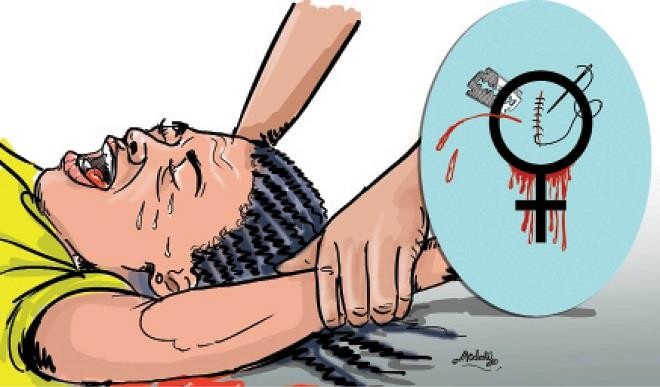
“I was circumcised when I was 14 years old, alongside my mates; it was a norm in Ebonyi State, those days.
“This tradition signifies that a girl has come of age, and is used to initiate girls into womanhood. Women take great joy in the practice. Most of us circumcised are kept in a room to heal, fed and treated specially by the older women,” Nkechi Amadi recalls.
“Am presently unmarried at 40 years of age. I live with the pain every day; the pain is one you don’t forget in a hurry. Imagine the torture when you want to ease yourself, especially with that grave injury between your legs, it’s easier said than pictured or experienced,” she further said.
Ene Joshua is now 30 years old, she was circumcised when she turned 15. She said the pain is something she still lives with.
“The experience flashes before your eyes, and dampens the ecstasy of love making. I am sure am frigid; sex just does nothing for me. That experience has ruined me for life. I have never had an orgasm,” she laments.
Female Genital Mutilation is a violation of the human rights of girls and women and a form of gender-based violence.
According to the United Nations Children Fund (UNICEF), FGM/C is a cultural practice with devastating medical, social, emotional, legal and economic repercussions for young girls and women.
The fund explained that the term refers to all procedures involving partial or total removal of the female external genitalia or other injury to the female genital organs for cultural or other non-medical reasons.
The UNFPA, also working to eliminate the practice of FGM/C, added that it has no medical benefits and so violates the human rights of women and girls and jeopardizes their health, rights and overall well-being.
A thought emphasized by the UNICEF Representative in Nigeria Mohamed Fall who said “every study and every bit of evidence we have shows there is absolutely no benefit to mutilate or to cut any girl or woman for non-medical reasons. It is a practice that can cause severe physical and psychological harm.”
The 2013 National Demographic and Health Survey revealed that five states in Nigeria have rates of Female Genital Mutilation and Cutting (FGM/C) that are more than 60 per cent.
The report revealed that Osun and Ebonyi states have the highest prevalence at 77 and 74 per cent respectively.
The other states are Ekiti, 72 per cent; Imo, 68 per cent; and Oyo, 66 per cent.
Globally, at least 200 million girls and women in 30 countries alive today have suffered some form of Female Genital Mutilation/Cutting (FGM/C) as stated by fact sheet released by the United Nation Children Fund (UNICEF) and United Nation Population Fund (UNFPA).
According to the survey, the practice though concentrated in Africa, is practiced in some communities in Asia, Latin America, and the Arab states.
In a desperate attempt to stop the practice, in 2008, the UNFPA-UNICEF Joint Programme on Female Genital Mutilation was established and has since supported 17 countries in undertaking holistic and integrated work to end FGM/C.
So far, 13 countries have created policies and legal provisions and budget allocations to fight against FGM/C while more than 1.6 million girls and women have received services for FGM/C through various interventions.
According to the United Nation organisations, more than 18,300 communities, comprising about 25.5 million people have disavowed FGM/C.
But despite this laudable intervention, some communities still continue to indulge in the practice.
In Imo State, Ogechi Nwosu who said she inherited the trade from her mother, added that the practice was the only source of livelihood she indulged in to cater for her family.
Asked if given another source of livelihood she would give that up, she said, hesitantly, “I will try, but it’s my profession. What will I tell mothers when they call me to circumcise their girls.
“Even if I refuse they will patronize another person to do the job. In my village there are five of us doing this business, so you see there is competition.”
In 2016, the UNFPA-UNICEF Joint Programme, working with governments, civil society and communities, said they were able to achieve some positive results in their struggle to end the menace.
In a fact sheet provided by UNICEF and UNFPA, they numerated the result to include, public declarations of abandonment of female genital mutilation made in 2,906 communities across 15 countries and 10,080 families in Egypt, reaching a total of about 8.5 million people.
They provided access to prevention, protection and treatment services to more than 730,000 girls and women, while in some instances the perpetrators were brought to justice and laws enforced.
According to them, 71 arrests were made, 252 FGM/C cases tried in court with 72 convictions, while four countries – Eritrea, Nigeria, Mauritania and Uganda – introduced FGM/C-related budget lines.
For many girls yet unborn and for those quickly approaching the forbidden age, this is a welcome development, as if fully implemented it will prevent them from undergoing the life time trauma.
Girls 14 and younger represent 44 million of those who have been cut, with the highest prevalence of FGM/C among this age in Gambia at 56 per cent, Mauritania 54 per cent and Indonesia where around half of girls aged 11 and younger have suffered the practice.
Countries with the highest prevalence among girls and women aged 15 to 49 are Somalia (98 per cent), Guinea (97 per cent) and Djibouti (93 per cent). In most of the countries the majority of girls were cut before their fifth birthday.
Momentum to address FGM/C is growing. Prevalence rates among girls aged 15 to 19 have declined in the last 30 years, such as in Liberia by 41 percentage points, in Burkina Faso (by 31), in Kenya (by 30) and in Egypt (by 27).
In February 2016, wife of the President, Hajiya Aisha Buhari, launched a national campaign to end FGM/C, calling on all parties to work together to halt this harmful practice.
Her call underlines the need for collective action at every level.
The Minister of Women Affairs and Social Development, Hajiya Aisha Jummai Alhassan, said the ministry would work with its donor partners and all wives of governors of the affected states to stop the practice.
She added that advocacy and campaigns would be launched in those states to underscore the harmful effect it had on girls who were circumcised.
The elimination of FGM/C has been sought for by numerous intergovernmental organisations, including the African Union, the European Union and the Organization of Islamic Cooperation, as well as in three resolutions of the United Nations General Assembly.
It would be recalled that the Sustainable Development Goals, the global compact adopted in 2015 by 193 United Nations Member States, called for an end to FGM/C by 2030 under Goal 5 on Gender Equality, Target 5.3 Eliminate all harmful practices, such as child, early and forced marriage and female genital mutilation.
The United Nations Population Fund (UNFPA) estimates the need to invest about $980 million to have a significant impact in tackling FGM/C between 2018 and 2030.

 Join Daily Trust WhatsApp Community For Quick Access To News and Happenings Around You.
Join Daily Trust WhatsApp Community For Quick Access To News and Happenings Around You.


